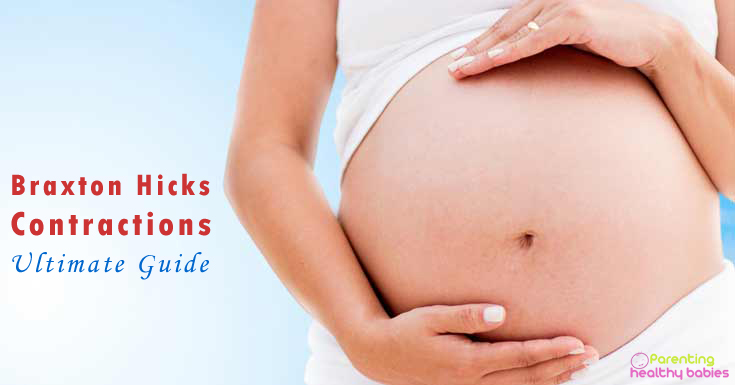The entire journey of pregnancy from the start to the finish is like a rollercoaster ride with all the body changes. As you approach the end of pregnancy, you constantly watch out for any kind of contraction that your body may be experiencing. Contractions are like your alarm clock, keeping you alert till it progresses or diminishes. But are all contractions real? Do they all signal signs of labour and delivery? No, some contractions are false and are commonly referred to as Braxton Hicks contractions.
These contractions are like practice for the real ones coming and keeps your body prepared for labour. Listed below is a complete guide to Braxton Hicks contractions and what you should know about them.
What are Braxton Hicks Contractions?
Braxton Hicks contraction are false labour contractions that give you the sense of real labor but do not progress with time. It gradually disappears after a few moments. Named after Dr Braxton who first came out with this theory, Braxton contractions generally start in the late second trimester or third trimester of pregnancy. Even those these contractions can thin the cervix, they generally do not progress into delivery unless you are in the last few days of your term.
Pattern of Braxton Hicks Contractions
Braxton Hicks contractions are like real contractions but irregular and keep returning back after a while. It begins with a tightening sensation in the uterus and later move higher to the stomach. Mostly it resembles and mimics the feeling of menstrual cramps. It keeps arriving from time to time specially in the evening or late night after an active day.
Signs and Symptoms of Braxton Hicks Contraction
It is important to know how Braxton Hicks contraction feels like in order not to panic, until you are in the last few weeks of your pregnancy. Some signs of Braxton Hicks contractions include
- Hardening or tight sensation in the front of the uterus
- Not long lasting.
- Disappears after 20-30 minutes
- Come and go away on their own without progressing
- Decreases over time with rest and intake of foods
- Contractions go away after emptying bladder or changing position.
Unlike real labour, Braxton Hicks contractions are
- Not very painful
- Never come closer together
- Do not progress or get stronger
- Do not happen at regular intervals
Difference between Real and Braxton Hicks contractions
Real contractions happen in the late third trimester of pregnancy, generally between 37 to 40 weeks of gestation. These contractions occur when the body releases a hormone called “oxytocin”. This hormone triggers the uterus to contract and causes thinning of the cervix.
Real contractions begin with the tightening of the uterus in pelvic region and each contraction progressing over time to a more intense contraction. They are generally painful and grow stronger with time. Each contraction gets closer together and they do not disappear with time. Real contractions finally lead to water breaking and progress into labour.
Braxton contractions even though similar to real contractions, they have major differences. Braxton contractions can appear in late second trimester and also in the early third trimester. It follows no regular pattern and keeps occurring and disappearing from time to time. Although it causes a tightening sensation in the uterus and abdomen, they are generally not painful. It disappears within 20 minutes and reduces with change in position, rest and intake of fluids.
What to do if you are having Braxton Contractions?
Do not panic. Even if they are not real, there is lot to learn from these false contractions. Here is what you can do to ease yourself from Braxton contractions
Practice for true labour
Funny as it may sound, practising your body for true labour with Braxton contractions help you prepare for true labour. It keeps your mind calm and focussed during true labour. Relax and meditate when you experience Braxton Hicks contractions.
Drink Plenty of Fluids
In many cases, the common cause of Braxton Hicks contractions is dehydration. So keep your body hydrated by drinking plenty of fluids in the form of water or juices.
Take a walk
Distracting yourself and taking a short walk can help ease Braxton contractions. If they do not subside, then you may be heading into real labour.
Relax
A good hot bath or calming music can help soothe the muscles and nerves. So if you are experiencing false contractions, you can take a quick hot shower and listen to some soothing music. Taking a nap for a short while also helps reduce Braxton contractions.
Check for magnesium deficiency
Many pregnant women suffer from magnesium deficiency. Lack of magnesium makes the body prone to muscle spasms and increases the chances of false contractions. Talk to your doctor to check for magnesium deficiency and take a supplement if required.
When to contact your doctor?
Any form of contraction after 37 weeks is natural and a sign of true labour. But if you experiencing contractions before 37 weeks that are getting rhythmic and do not fade with time, then you may be entering into pre-term labour. Some of the symptoms that you need to watch out for are
- Regular and painful contractions
- Water break
- Vaginal bleeding
- Severe abdominal pain
- Increased vaginal discharge
- Pushing down pressure in the pelvis region
- Lower back pain
It a common sign to panic too early or realise too late. Keep a watch out for your body symptoms once you enter your third trimester. This guide on Braxton Hicks contractions will help you understand the true difference of false and true labour.
References
https://www.webmd.com/baby/guide/true-false-labor#1
https://www.babycenter.com/0_braxton-hicks-contractions_156.bc













